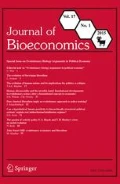Abstract
The adaptive pressures facing humans and other animals to make decisions quickly can be met both by increasing internal information-processing speed and by minimizing the amount of information to be used. Here we focus on the latter effect and ask how, and how well, agents can make good decisions with a minimal amount of information, using two specific tasks as examples. When a choice must be made between simultaneously-available options, minimal information in the form of binary recognition (whether or not each item is recognized) can be used in the recognition heuristic to choose effectively. When options are encountered sequentially one at a time, minimal information as to whether or not each option is the best encountered so far is sufficient to guide agents using a simple search-cutoff rule to high performance along several choice criteria. Both of these examples have important economic as well as biological applications, and show the power of simple fast and frugal heuristics to produce good decisions with little information.
References cited
Bergstrom, Carl T. & Leslie A. Real. 2000. Towards a theory of mutual mate choice: lessons from two-sided matching. Evolutionary Ecology Research 2: 493–508.
Bolle, Friedel. 1979. Das Problem des optimalen Stoppens: Modelle und Experimente. Ph.D. thesis, University of Hamburg, Germany. Verlag Peter D. Lang, Frankfurt am Main.
Borges, Bernhard, Daniel G. Goldstein, Andreas Ortmann & Gerd Gigerenzer. 1999. Can ignorance beat the stockmarket? Pp. 59–72 in Gerd Gigerenzer, Peter M. Todd & the ABC Research Group, Simple Heuristics That Make Us Smart, Oxford University Press, New York.
Boyd, Robert & Peter J. Richerson. 1985. Culture and the evolutionary process. University of Chicago Press, Chicago.
Corbin, Ruth M. 1980. The secretary problem as a model of choice. Journal of Mathematical Psychology 21:1–29.
Corbin, Ruth M., Chester L. Olson & Mona Abbondanza. 1975. Context effects in optional stopping decisions. Organizational Behavior and Human Performance 14:207–216.
Dawes, Robyn M. 1979. The robust beauty of improper linear models in decision making. American Psychologist 34:571–582.
DeGroot, Morris H. 1970. Optimal statistical decisions, chap. 13. McGraw-Hill, New York.
Ferguson, Thomas S. 1989. Who solved the secretary problem? Statistical Science 4:282–296.
Galef, Bennett G., Jr. 1987. Social influences on the identification of toxic foods by norway rats. Animal Learning and Behavior 15:327–332.
Gigerenzer, Gerd & Daniel G. Goldstein. 1996. Reasoning the fast and frugal way: models of bounded rationality. Psychological Review 103:650–669.
Goldstein, Daniel G. & Gerd Gigerenzer. 1999. The recognition heuristic: how ignorance makes us smart. Pp. 37–58 in Gerd Gigerenzer, Peter M. Todd & the ABC Research Group, Simple Heuristics That Make Us Smart, Oxford University Press, New York.
Henrich, Joe & Robert Boyd. 1998. The evolution of conformist transmission and between-group differences. Evolution and Human Behavior 19:215–242.
Hertwig, Ralph & Peter M. Todd. In press. More is not always better: the benefits of cognitive limits. In L. Macchi & D. Hardman (ed.) The Psychology of Reasoning and Decision Making: A Handbook. John Wiley & Sons, Chichester, UK.
Hey, John D. 1982. Search for rules for search. Journal of Economic Behavior & Organization 3:65–81.
Johnstone, Rufus A. 1997. The tactics of mutual mate choice and competitive search. Behavioral Ecology and Sociobiology 40:51–59.
Kahan, James A., Amnon Rapoport & Lyle V. Jones. 1967. Decision making in a sequential search task. Perception & Psychophysics 2:374–376.
Moon, Philip & Andrew Martin. 1990. Better heuristics for economic searchÐexperimental and simulation evidence. Journal of Behavioral Decision Making 3:175–193.
Mosteller, Frederick. 1965. Fifty challenging problems in probability with solutions. Dover Publications, Inc. Reprint published by Dover in 1987. Originally published in 1965 by Addison-Wesley, Reading, MA.
Payne, John W., James R. Bettman & Eric J. Johnson. 1993. The adaptive decision maker. Cambridge University Press, New York.
Quine, Malcolm P. & J. S. Law. 1996. Exact results for a secretary problem. Journal of Applied Probability 33:630–639.
Sargent, Thomas J. 1993. Bounded rationality in macroeconomics. Oxford University Press, Oxford.
Schotter, Andrew & Yale M. Braunstein. 1981. Economic search: an experimental study. Economic Inquiry 19:1–25.
Seale, Darryl A. & Amnon Rapoport. 1997. Sequential decision making with relative ranks: an experimental investigation of the ‘secretary problem’. Organizational Behavior and Human Decision Processes 69:221–236.
Seale, Darryl A. & Amnon Rapoport. 2000. Optimal stopping behavior with relative ranks: the secretary problem with unknown population size. Journal of Behavioral Decision Making 13:391–411.
Shanteau, James. 1992. How much information does an expert use? Is it relevant? Acta Psychologica 81:75–86.
Simon, Herbert A. 1990. Invariants of human behavior. Annual Review of Psychology 41:1–19.
Stigler, George J. 1961. The economics of information. Journal of Political Economy 69:213–225.
Todd, Peter M. 1999. Simple inference heuristics versus complex decision machines. Minds and Machines 9:461–477.
Todd, Peter M. 2000. Fast and frugal heuristics for environmentally bounded minds. Pp. 51–81 in Gerd Gigerenzer & Reinhard Selten (ed.) Bounded Rationality: The Adaptive Toolbox, MIT Press, Cambridge, MA.
Todd, Peter M. & Geoffrey F. Miller. 1999. From pride and prejudice to persuasion: realistic heuristics for mate search. Pp. 287–308 in Gerd Gigerenzer, Peter M. Todd & the ABC Research Group, Simple Heuristics That Make Us Smart, Oxford University Press, New York.
Vriend, Nicolaas J. 1996. Rational behavior and economic theory. Journal of Economic Behavior & Organization 29:263–285.
Author information
Authors and Affiliations
Rights and permissions
About this article
Cite this article
Dudey, T., Todd, P.M. Making Good Decisions with Minimal Information: Simultaneous and Sequential Choice. Journal of Bioeconomics 3, 195–215 (2001). https://doi.org/10.1023/A:1020542800376
Issue Date:
DOI: https://doi.org/10.1023/A:1020542800376

